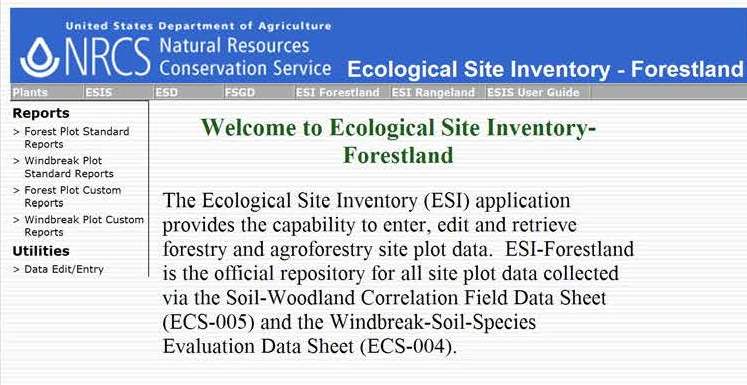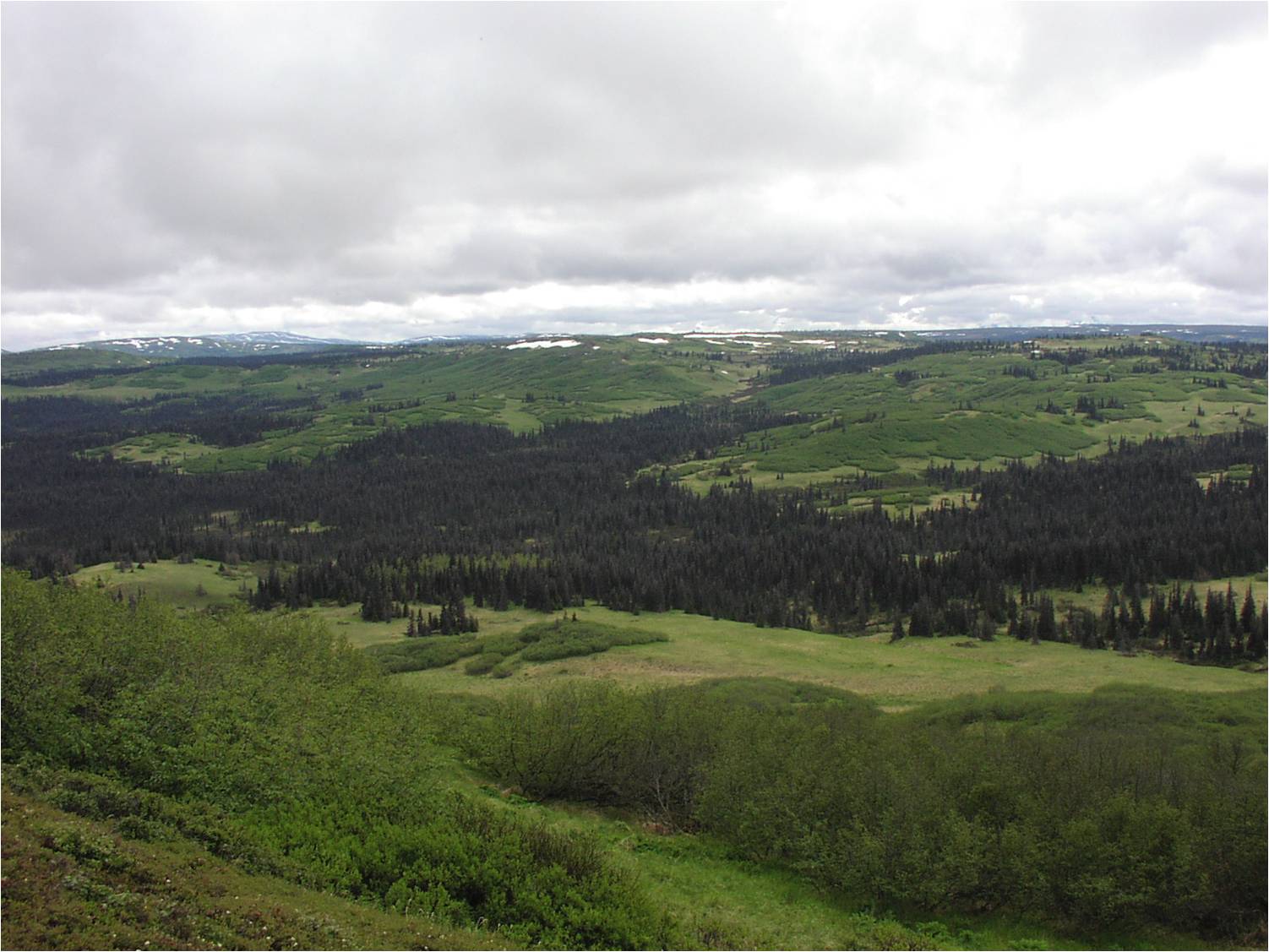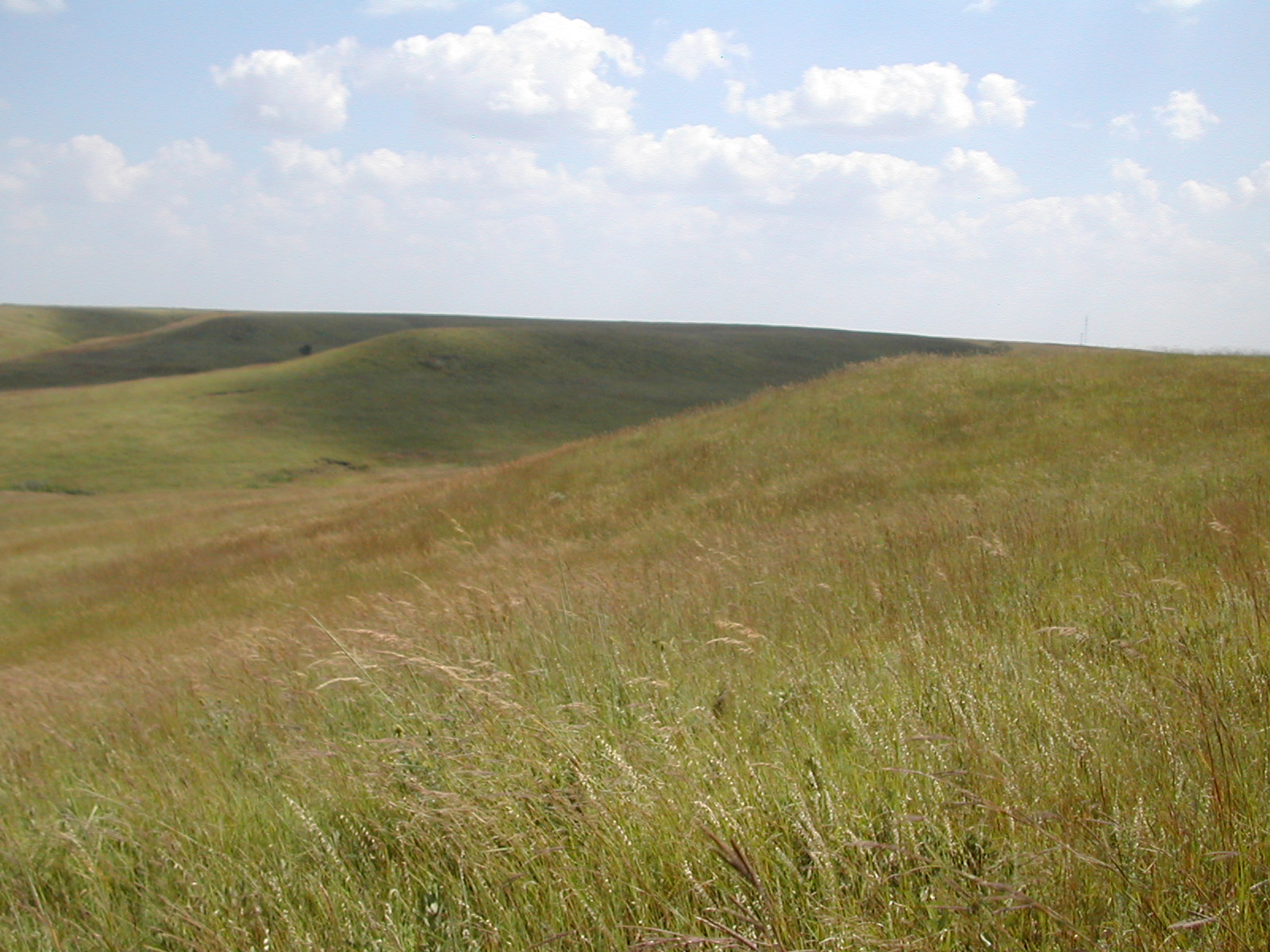Ecological Site Descriptions
Where can I find Ecological Site Description Reports?
 NRCS Ecological Site Description (ESD) reports are stored and accessed within the Ecological Site Information System (ESIS). All approved and completed ESDs, both rangeland and forestland sites, are available to the general public from ESIS. Find out more about ESIS....
NRCS Ecological Site Description (ESD) reports are stored and accessed within the Ecological Site Information System (ESIS). All approved and completed ESDs, both rangeland and forestland sites, are available to the general public from ESIS. Find out more about ESIS....
Ecological Site Inventory (ESI):
The Ecological Site Inventory (ESI) section of ESIS allows for data entry of rangeland, forestry, and agroforestry inventory plots. This plot data is available to the public in a variety of report formats from ESI.

I Want to Enter/View Rangeland Ecological Site Data...

I Want to Enter/View Forestland/Windbreaks Ecological Site Data...
What are Ecological Site Descriptions (ESDs)?
Ecological Site Descriptions (ESDs) are reports that provide detailed ecological information and data about a particular kind of land - a distinctive Ecological Site. ESD information is presented in four major categories:
-
Site Characteristics - physiographic, climate, soil, and water features
-
Plant Communities – vegetation states, species composition, and ecological dynamics
-
Site Interpretations – best management of the site and its related resources
-
Supporting Information – information and data sources, relationship to other ecological sites
How Are Ecological Sites Defined and Delineated? 
Looking across any landscape it is not difficult to recognize that some parts are different from other parts in regard to the plant communities present, especially as to the kinds and amounts of vegetation. To understand this variation across the landscape, we classify these different parts into units called Ecological Sites. An Ecological Site is defined as “a distinctive kind of land with specific characteristics that differs from other kinds of land in its ability to produce a distinctive kind and amount of vegetation”. Any land inventory, analysis, and resulting management decisions require the knowledge of these individual sites and their interrelationships to one another on the landscape. The Ecological Site Description is the document that will contain information about the individual Ecological Sites.
Ecological Site Types
There are two types of Ecological Sites – Rangeland site and Forestland sites. These two site types are separated based on the Reference Plant Community type.
 A site type of Forestland is assigned and described where a 25% overstory canopy of trees, as determined by crown perimeter-vertical projection, dominated the Reference Plant Community vegetation. A tree is defined as a woody-stemmed plant growing to 4 meters in height at maturity.
A site type of Forestland is assigned and described where a 25% overstory canopy of trees, as determined by crown perimeter-vertical projection, dominated the Reference Plant Community vegetation. A tree is defined as a woody-stemmed plant growing to 4 meters in height at maturity.
 A site type of Rangeland is assigned where overstory tree production was not significant in the Reference Plant Community vegetation.
A site type of Rangeland is assigned where overstory tree production was not significant in the Reference Plant Community vegetation.
Reference Plant Communities
The Reference Plant Community for a site in North America is the plant community that existed at the time of European immigration and settlement. It is the plant community that was best adapted to the unique combination of environmental factors associated with the site. This plant community was in dynamic equilibrium with its environment. It is the plant community that was able to avoid displacement by the suite of disturbances and disturbance patterns that naturally occurred within the area occupied by the site. Natural disturbances, such as drought, fire, grazing of native fauna, and insects were inherent in the development and maintenance of these plant communities. The effects of these disturbances are part of the range of characteristics of the site that contribute to that dynamic equilibrium. Fluctuations in plant community structure and function caused by the effects of these natural disturbances establish the boundaries of dynamic equilibrium. They are accounted for as part of the range of characteristics for an Ecological Site. Plant communities that are subjected to abnormal disturbances and physical site deterioration or that are protected from natural influences, such as fire, for long periods seldom typify the historic Reference Plant Community and may exist in a steady state that is different from the historic Reference Plant Community.
The Reference Plant Community of an ecological site is not a precise assemblage of species for which the proportions are the same from place to place or from year to year. In all plant communities, variability is apparent in productivity and occurrence of individual species. However, spatial boundaries of the communities can be recognized by characteristic patterns of species composition, association, and community structure.
At times, normally less frequently occurring plants may increase on a site, or plants not formerly found in the Reference Plant Community may invade the site. The presence or abundance of these plants may fluctuate greatly because of differences in microenvironment, weather conditions, or human actions. Consequently, using them for site identification can be misleading, so they should not be used to differentiate sites. Site differentiation, characterization, and determinations are based on the plant community that developed along with the soils. A study of several locations over several years is needed to differentiate and characterize a site.
Where changes in soils, aspect, topography, or moisture conditions are abrupt, ecological site boundaries are distinct. Boundaries are broader and less distinct where plant communities change gradually along broad environmental gradients of relatively uniform soils and topography. Although some plant communities may appear to be along a continuum, distinctive plant communities can be identified and described. These communities occur with predictable regularity and are associated with concurrent differences in soil, topography, hydrology, or climate that can also be recognized.
Differentiating Ecological Sites
The following criteria are used to differentiate one ecological site from another:
· Significant differences in the species or species groups that are in the characteristic plant community.
· Significant differences in the relative proportion of species or species groups in the characteristic plant community.
· Soil factors that determine plant production and composition, the hydrology of the site, and the functioning of the ecological processes of the water cycle, mineral cycles, and energy flow.
· Differences in the kind, proportion, and production of the overstory and understory plants due to differences in soil, topography, climate, and environment factors, or the response of vegetation to management.
The data comprising a ecological site description is presented in four major categories:
· Site Characteristics -- Identifies the site and describes the physiographic, climate, soil, and water features associated with the site.
· Plant Communities -- Describes the ecological dynamics and the common plant communities comprising the various vegetation states of the site. The disturbances that cause a shift from one state to another are also described.
· Site Interpretations -- Interpretive information pertinent to the use and management of the site and its related resources.
· Supporting Information – Provides information on sources of information and data utilized in developing the site description and the relationship of the site to other ecological sites.